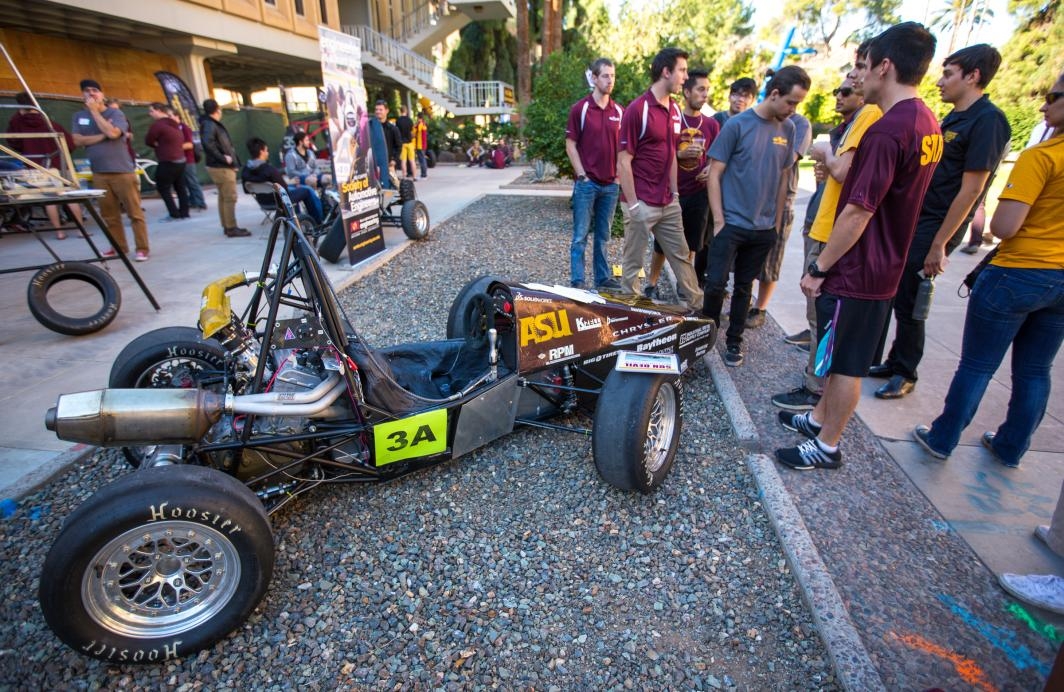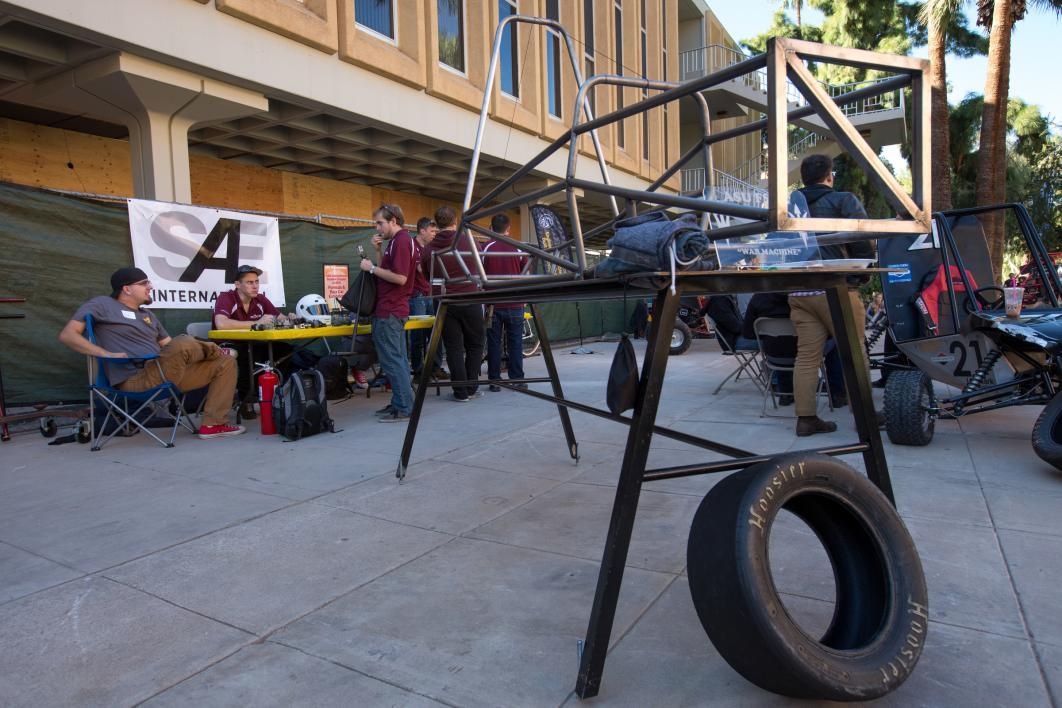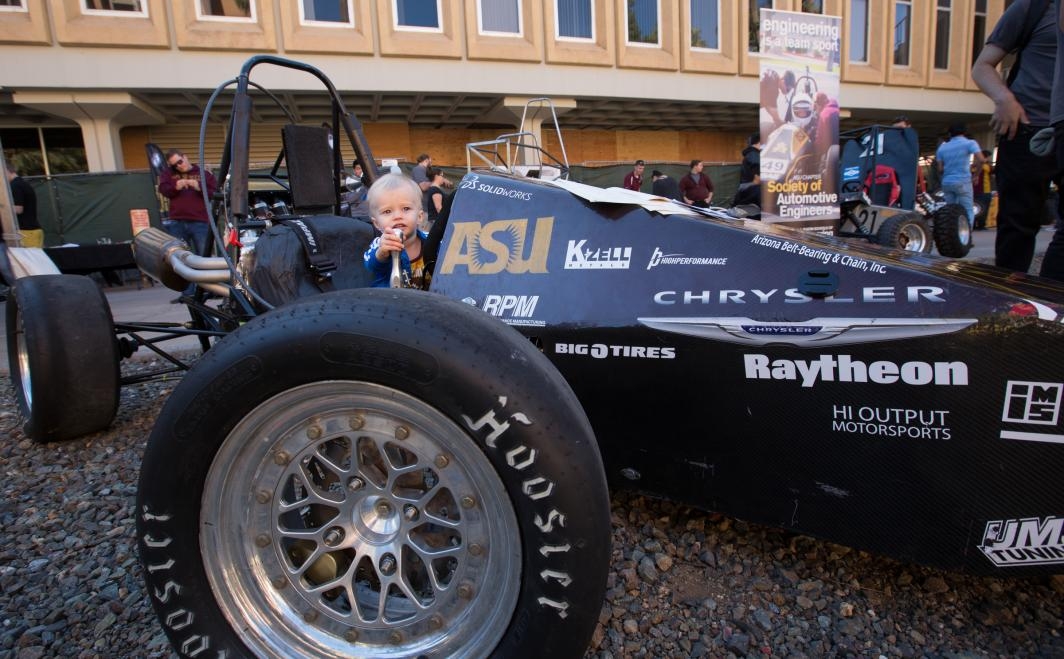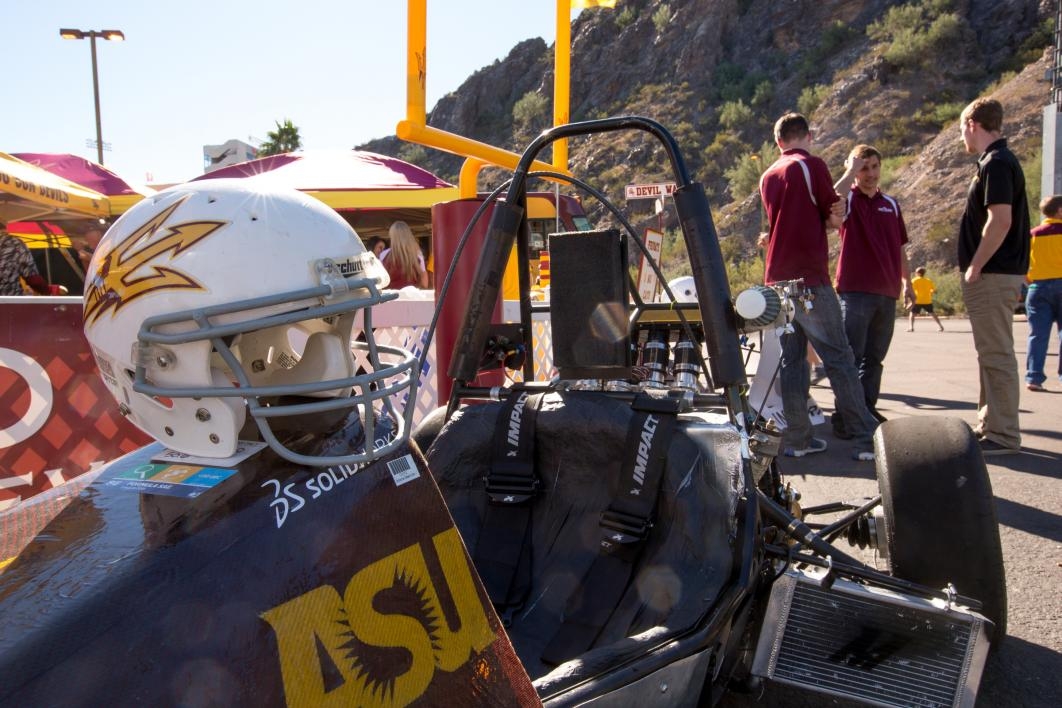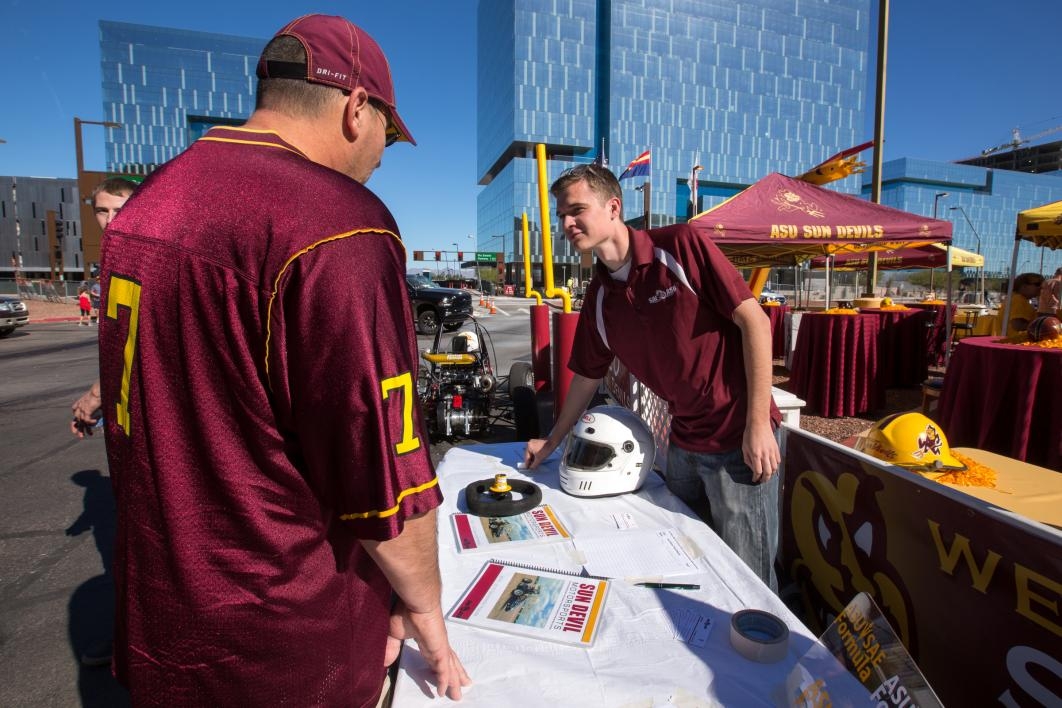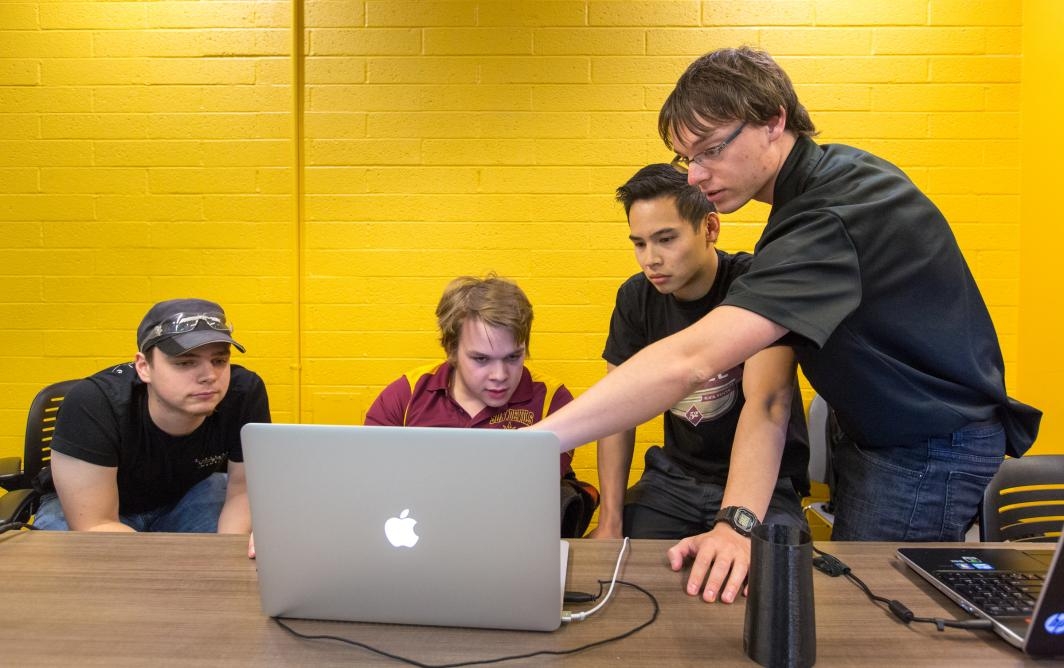Editor’s note: This is the latest installation in a yearlong series about ASU's Formula SAEFormula SAE is a student design competition organized by the International Society of Automotive Engineers (now known as SAE International). team. Find links to previous stories at the end of this article.
It’s the Saturday of the Territorial Cup game. While a sea of students in gold T-shirts offering “No Pity for the Kitty” heads towards the stadium and hundreds of tailgate parties, the dedicated students of the Formula Society of Automotive Engineers are skipping Arizona State University’s most important day of the year to work on their race car.
Financially, they’re in better shape than they were a few weeks ago, when they had $600 in the bank. It’s relative. Instead of hanging on by the skin of their teeth, they’re hanging on by their teeth.
“We’re not overfunded by any means,” said team manager Troy Buhr, a junior in mechanical engineering.
Buhr is in the stadium parking lot at an unbelievably elaborate tailgate party — capable of hosting more than 70 people — but he’s not hoisting a beer. Last year’s car sits beside a Formula SAE table with promotional materials. Buhr’s out to see if he can win interest and hopefully some money at the same time.
“We’re here at the tailgate to get our name out there,” he said. “At an event like this it’s going to be individuals.”
The tailgate was hosted by Ray Bilby, vice president of sales and marketing at Trafficade, Formula SAE’s latest sponsor. Trafficade is an Arizona traffic-safety company, specializing in things like pavement milling and asphalt repair. It’s appropriate they sponsor a race car, because a car is the vantage point from which most people watch their work.
“We’re still working hard on sponsorship,” Buhr said. “We’re covering our bills. ... We’re in a better place than we were, for sure.”
The club got a windfall recently when the university reimbursed them $4,000 in travel expenses from last summer’s trip to the national competition in Lincoln, Nebraska.
Ford Motor Company confirmed a $2,500 sponsorship, but that check won’t arrive for six weeks.
“If you try really hard, people tend to want to help you out,” Buhr said.
The student-led team is working toward the June Formula SAE competition in Lincoln. They had originally wanted to have the car built by January, so the majority of the spring semester could be spent on testing and improvements.
Building up to deadlines
Chief engineer Wes Kudela shuttled between the table at the stadium and the shop on campus where the car is being built. The build was going well, he said, but the nagging issue of money continued to be the biggest obstacle.
“The only thing we’re hurting on is lack of finances to buy stuff we need,” said Kudela, a senior in mechanical engineering. The 110-student-strong club has spent so much time getting last year’s car into shape for Homecoming and the Territorial Cup that Kudela reevaluated and updated deadlines.
“I gave everyone deadlines they need to meet to have a running car by January 2,” he said. “Everyone got a little pressure put on them, but I think that’s good. ... The main idea is that we are decently ahead of the curve with our chassis manufacturing. That’s encouraging, but that’s not something I want people to use as a comfort zone.”
The team will buy some parts to keep everyone busy in coming weeks.
“Once we buy those parts, it will give all the sub-team leads stuff to do on Saturdays,” Kudela said.
A lot of members plan to stay on campus to get work done over the holiday breaks. Kudela is going home for two weeks instead of four so he can focus on the car. “That will be awesome,” he said.
The side-pod problem
Though there were only 15 engineering students instead of the usual 60 or 70 in the shop on the weekend of the big game, they were busy measuring, fitting, cutting, sanding and deburring struts for the chassis.
All struts are important, but these vertical struts will carry the engine and most of the weight. Gaps between tubes need to be as tight as possible for strength. Ultimately a thicker weld makes for a weaker joint.
The project is divided into eight teams. Martin Morrow is the leader of the aerodynamics team.
“We’re in charge of the aero aspect of the car,” he said. On the Sun Devil Motorsports–16 (the car’s official name), that means the nose cone and radiator side pod. Normally a Formula car has wings the aero team would design and build, but they can’t afford wings this year.
The aero team makes 3-D models of their components in computer-aided design programs, then tests them with engineering software.
“It’s a lot easier and simpler,” said Morrow, a junior majoring in aerospace engineering.
“Everyone got a little pressure put on them, but I think that’s good. ... The main idea is that we are decently ahead of the curve with our chassis manufacturing. That’s encouraging, but that’s not something I want people to use as a comfort zone.”
— chief engineer Wes Kudela
When they’ve settled on designs and printed out 3-D prototypes, they will put them in one of the two wind tunnels on the Tempe campus and “make sure the theoretical data matches the experimental data,” Morrow said.
As with the rest of the project, the aero team needs a carbon-fiber sponsor. What they have in mind is a triple-layered sandwich of material that won’t rip off the bolts when the car is flying around the track.
The nose cone may be a solid piece, or it may have a top that slides back so that brake lines and pedals can be accessed. “Ideally you wouldn’t need to get in there,” Morrow said. “Ideally.”
It’s the first time ASU’s Formula SAE team has had a dedicated aerodynamics team. They don’t have the historical data teams at other universities have. “There’s a learning curve,” Morrow said.
The toughest problem they have to crack will be designing and testing the radiator side pod. “How small can we make our inlet and still cool the engine at any speed?” Morrow characterized it.
Scott Gramke, a senior majoring in mechanical engineering, leads the drive team. His team’s responsibility covers “pretty much anything after the engine and before the wheels.”
They’re redesigning the differential, which aims engine power at the wheels and transmits power to the wheels while they’re turning at different speeds. The drive team faces an important decision. Do they use the differential from last year’s car, or can they buy an off-the-shelf differential costing $2,600 that they have spec’d out?
“The one we have would cost a couple of hundred dollars” to get test-ready, Gramke said. Their engineering goal is to reduce weight.
To support the ASU Formula SAE team, click here, then select the “write-in” circle in the “supporting” category and enter the following in the box: "ASU-Society of Automotive Engineers 30006731".
Previous stories in this series:
Oct. 14: Tempe Drift: How an underdog student engineering team is building a race car from the ground up.
Nov. 4: Racing time and money to build a fast car.
Look for the next installment Dec. 10.
More Science and technology

ASU-led space telescope is ready to fly
The Star Planet Activity Research CubeSat, or SPARCS, a small space telescope that will monitor the flares and sunspot activity of low-mass stars, has now passed its pre-shipment review by NASA.…

ASU at the heart of the state's revitalized microelectronics industry
A stronger local economy, more reliable technology, and a future where our computers and devices do the impossible: that’s the transformation ASU is driving through its microelectronics research…

Breakthrough copper alloy achieves unprecedented high-temperature performance
A team of researchers from Arizona State University, the U.S. Army Research Laboratory, Lehigh University and Louisiana State University has developed a groundbreaking high-temperature copper alloy…



